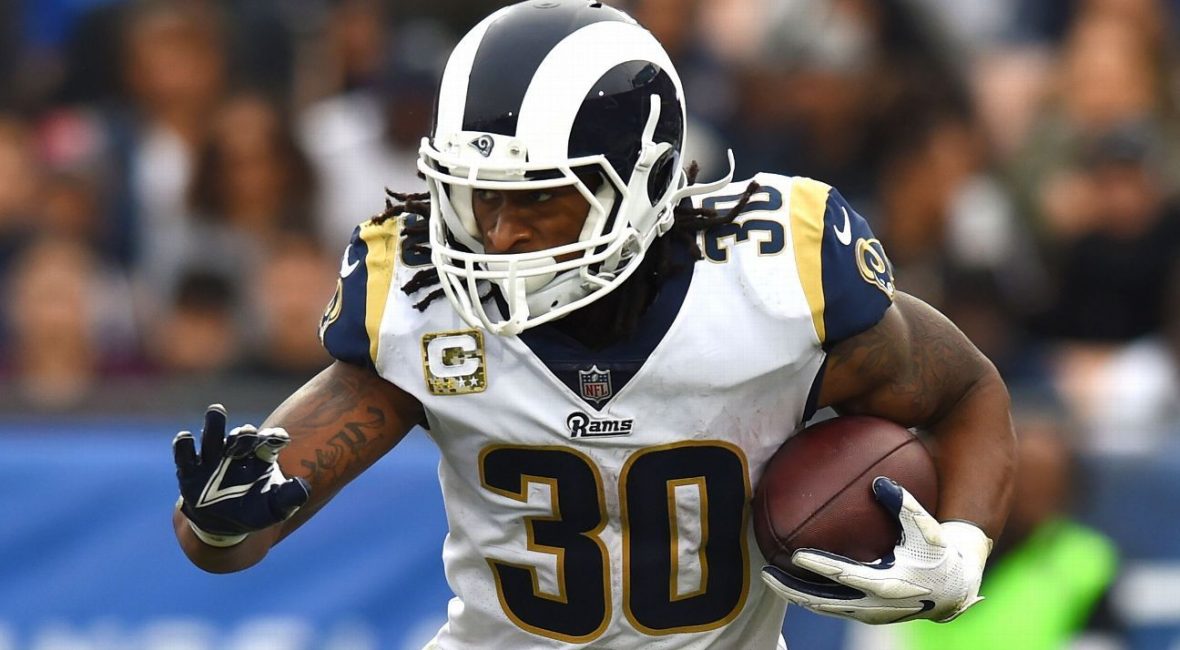Gurley for MVP? Sorry, he wasn't even NFL's best running back

If, at the last minute, the NFL added a most valuable running back award to its NFL Honors program on Saturday, Todd Gurley would be the runaway favorite. He is the only running back in the MVP conversation, after all.
He would also be the wrong choice. Because there was another running back who produced much more than Gurley in far fewer opportunities: Alvin Kamara.
Gurley’s candidacy for MVRB (this make-believe award already has an acronym and everything) stems from him leading the league in yards from scrimmage (2,093) and in rushing and receiving combined touchdowns (19). Especially when considering that the next highest rushing/receiving touchdown total was 13 (by DeAndre Hopkins and Kamara), why isn’t the Rams running back the obvious choice here?
Because we have better tools to measure value than just yards and touchdowns these days. For starters, we’ll lean on a team’s expected points added (EPA) when the running back in question touches the ball or is targeted. (A primer on EPA can be found here.)
The Saints offense was incredibly efficient when getting or attempting to get Kamara the ball. Among players with at least 100 combined rushes and targets, Kamara not only had the best rate of team EPA/attempted touch (0.32), but he almost doubled up the next most efficient team EPA per attempted touch running back, Washington’s Chris Thompson (0.18).
Which is nice and impressive. But we’re looking for the most valuable running back, and so this isn’t strictly a question of efficiency. Kamara took time to work his way into a major role in the offense and only had 218 attempted touches, compared to 348 from Kareem Hunt and 363 from Todd Gurley. So there couldn’t possibly have been a higher team EPA total on his attempted touches, right? Well…
Best Team EPA among NFL running backs, 2017
It’s not even close.
How did Kamara get there? By being part of plays like his 74-yard touchdown run against the Rams in Week 12, in which he went untouched for 64 yards before casually breaking a tackle to skip into the end zone. And his 33-yard conversion on fourth-and-5 later in that same game, recorded while trying to keep the Saints alive. Or the 33-yard touchdown on a screen pass against the Bucs in Week 9, in which the former University of Tennessee running back appeared destined to hit the ground at the 12-yard line before slipping out of Justin Evans’ grasp and scoring.
By the way, the table above doesn’t even include Kamara’s highest EPA play of the season: a 106-yard kick return in Week 17 against the Bucs.
It’s not that Gurley didn’t have plays like this, it’s just that, in total, those Kamara plays added so much more. One area that Gurley was weak in, though: third-and-1 runs. He converted only six of 14 attempts on such runs (43 percent) when the league average conversion rate on those rushes was almost 73 percent. Those kinds of misses are costly. (Kamara only attempted two such runs and converted one, for what it’s worth).
One note to keep in mind: Three passes intended for Gurley were intercepted (compared to zero for Kamara), which is likely just a stroke of bad luck for the Rams running back in this sort of study. Nonetheless, even if we only looked at completions — rather than targets — for those two running backs Kamara still leads, and it still isn’t remotely close.
You may have noticed a pattern among the five running backs listed above (Thompson probably gave it away): they are all pass-catching backs. And that’s not a coincidence, but rather a function of the fact that, in general, passing plays are more productive than running plays. On average, running plays have a negative EPA, so that the Rams added 0.00 expected points on Gurley runs this year isn’t really a knock: it’s above average.
On one hand, this shows the value of multi-dimensional running backs. On the other, we are talking about the most valuable running back. And it’s not their fault that running, on average a sub-optimal part of an offense, is part of the position’s job description. So if there was another running back who added more value on the ground than Kamara, that could muddy the waters here. The good news: there isn’t. Kamara led all backs in team EPA on running plays only as well. So he swept the running and passing game categories in 2017, which should just about do it.
Almost.
The last type of measurement we’ll consider here is win probability added. If we’re measuring the value of a running back’s plays by the degree to which they swung a game, then WPA is where we ought to look. Personally, I don’t think either EPA or WPA ought to be a catch-all for MVP. EPA doesn’t include enough context (like garbage time) but WPA relies on situations far too heavily. The truth is in between.
Regardless, WPA is Gurley’s best case for this pretend award. Gurley (cumulative win probability added of 1.93) trails Kamara (1.95) here too, but only just. But maybe, if there’s wiggle room somewhere, Gurley could pull ahead.
And of course there’s wiggle room. Because the dark cloud over this entire analysis is that we’re not measuring each player’s contribution. We’re measuring the team’s productivity on plays when the running back had an attempted touch. Even when Kamara does run or catch the ball, there are 10 other players on his team working for that same EPA result.
For quarterbacks, we’re further along. We’ve divided credit — a key component of Total QBR. (Quick aside: Tom Brady, Carson Wentz and eight other quarterbacks produced more EPA this season themselves, including a down-weighting for garbage time, than the Saints did on Kamara’s touches. So no running back this year should be in the MVP conversation.) But we’re not there yet for running backs. We don’t have a way to separate the runners’ contribution from his blockers.
Which is certainly a bummer until we remember that all the traditional statistics that we use also fail to divide credit as well. No one’s apportioning a percentage of Gurley’s yards to Andrew Whitworth or any of Kamara’s touchdowns to the threat of Michael Thomas.
If the EPA race were closer, we’d have to consider all of that gray area, and this would be a much more difficult (imaginary) honor to vote for. But it’s not all that close. Even with the razor thin margin in the WPA race, the rookie so handily blew away his competition in terms of sheer production that it’s safe to assume that after dividing credit the result would be the same: Kamara was 2017’s most valuable running back.
Brian Burke and Hank Gargiulo contributed to this story.
For more from ESPN Analytics, visit the ESPN Analytics Index.




